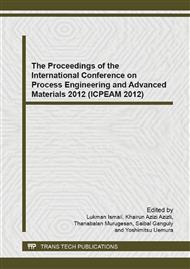[1]
European Union, Restriction of Hazardous Substance Directive (RoHS) 2002/95/EC. Official J of the European Union, L/37 (2003) 19-23.
Google Scholar
[2]
R.C. Prince, Crude Oil Biodegradation, Encyclopedia of Environmental Analysis and Remediation, Wiley, New York, (1988).
Google Scholar
[3]
IPPC Bureau, Reference Document on Best Available Techniques for Mineral Oil and Gas Refineries Reference Document on Best Available Techniques for Mineral Oil and Gas Refineries, Integrated Pollution Prevention and Control, Spain, (2001).
Google Scholar
[4]
A. Al-Futaisi, A. Jamrah, B. Yaghi and R. Taha, Assessment of alternative management techniques of tank bottom petroleum sludge in Oman. Hazar Mater, 141: 557-564. DOI: 10. 1016/j. hazmat. 2006. 07. 023.
DOI: 10.1016/j.jhazmat.2006.07.023
Google Scholar
[5]
Department of Environment, Environmental Quality Act 1974 (Act 127), E.Q. (Scheduled Waste) Regulation 2005, amendment P.U. (A) 294/2005, Percetakan Nasional Malaysia Berhad, (2005).
Google Scholar
[6]
T.L. Potter, Analysis of Petroleum Contaminated Soil and Water: An Overview, in: E. J Calabrese and P.T. Kostecki (Eds. ), Principles and Practices for Petroleum Contaminated Soils, Lewis Publisher, 1992, pp.1-14.
DOI: 10.1201/9780203742198-1
Google Scholar
[7]
APHA, 2540G Total, Fixed and Volatile Solid in Solid and Semisolid Sample, Standard Method for the Analysis of Water and Wastewater, 20th Ed., Washington, D.C., 1990, pp.2-59.
Google Scholar
[8]
APHA, 5520E Oil and Grease Extraction Method for Sludge Sample Standard, Method for the Analysis of Water and Wastewater, 20th ed., Washington, D.C., 1990, pp.5-39.
Google Scholar
[9]
USEPA, 1996. 8260b Volatile Organic Compounds by Gas Chromatography/Mass Spectrometry (GCMS), Rev 2, SW-846 Test Methods for Evaluating Waste, Physical/Chemical, http: /www. epa. gov/osw/hazard/testmethods/sw846/online/8_series. htm.
Google Scholar
[10]
APHA, 3030E Nitric Acid Digestion, Standard Method for the Analysis of Water and Wastewater, 20th Ed., Washington, D.C., 1990, pp.3-8.
Google Scholar
[11]
USEPA, 3570 Microscale Solvent Extraction, Rev 0, SW-846 Test Methods for Evaluating Waste, Physical/Chemical. http: /www. epa. gov/osw/hazard/test methods/sw846/online/3_series. htm.
Google Scholar
[12]
American Nuclear Soceity, ANSI/ANS 16. 1-2003 Measurement of the Leachability of Solidified Low-Level Radioactive Wastes by a Short Term Procedure. La Grande Park, IL, (2003).
Google Scholar
[13]
J. Pawliszyn and R.P. Belardi, The application of chemically modified fused silica fibers in the extraction of organics from water matrix samples and their rapid transfer to capillary columns. Water Pollution Res, 24 (1989) 179-191.
DOI: 10.2166/wqrj.1989.010
Google Scholar
[14]
Z. Abdullah Munir, S. Nor'ashikin and N.H. Mamat Ghani, Application of solid phase microextraction (SPME) in profiling hydrocarbons in oil spill cases. Malaysian J. Of Anal Sciences, 12 (2008) 46-52.
Google Scholar
[15]
Supelco, Solid Phase Microextraction: Theory and Optimization of Conditions, Bulletin 923, Sigma Aldrich Co., 1998, pp: 1-5.
Google Scholar
[16]
USEPA, 8270d Semivolatile for Organic Compounds by Gas Chromatography/Mass Spectrometry (GCMS), Rev. 4, SW-846 Test Methods for Evaluating Waste, Physical/ Chemical, 2007, http: /www. epa. gov/osw/hazard/testmethods/online/8_series. htm.
Google Scholar
[17]
USEPA, 8260c Volatile Organic Compounds by Gas Chromatography/Mass Spectrometry (GCMS), Rev 3, 2006, http: /www. epa. gov/osw/hazard/testmethods/sw846/online/8_series. htm.
Google Scholar
[18]
MADEP, Method for the Determination of Extractable Petroleum Hydrocarbons (EPH) , MADEP, 2004, http: /www. mass. gov. dep/cleanup/laws/eph0504. pdf.
Google Scholar
[19]
T. Wang, Quantitation by External Standard, in: J. Cazes (Ed. ), Encyclopedia of Chromatography, Marcel Dekker Inc., 2001, pp: 691-693.
Google Scholar
[20]
M.J. Pilgrim, Method AK 102 For Determination of Diesel Range Organics, Version 04/08/02, Alaska, 2011, http: /www. dec. state. ak. us/eh/docs/lab/cs/AK102. pdf.
Google Scholar
[21]
Y.M. Chan, P. Agamuthu and R. Mahalingam, Solidification and stabilization of asbestos waste from an automobile brake manufacturing facility using cement, Hazar. Mater. 77 (2000) 209-226.
DOI: 10.1016/s0304-3894(00)00244-2
Google Scholar
[22]
D. Grasso, Hazardous Waste Site Remediation: Source Control, Lewis Publisher, (1993).
Google Scholar


